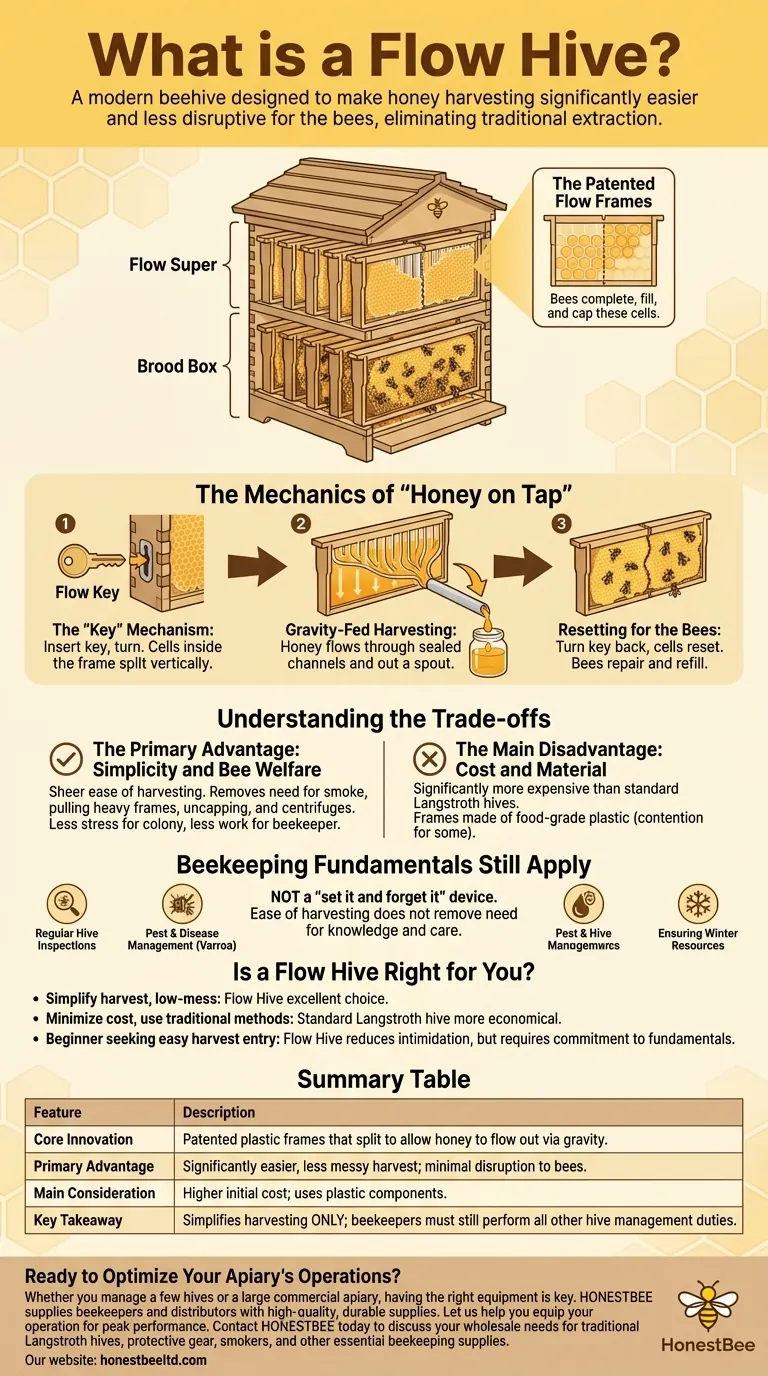At its core, a Flow Hive is a modern beehive designed to make honey harvesting significantly easier and less disruptive for the bees. It uses specially engineered frames that allow honey to be drained directly from the hive through a tap, eliminating the need for traditional, labor-intensive extraction equipment like a centrifuge.
The central innovation of the Flow Hive is its patented frame technology. By simply turning a key, the honeycomb cells within these frames split, creating channels that allow pure, filtered honey to flow out via gravity, ready for collection.

The Mechanics of "Honey on Tap"
The "magic" of the Flow Hive lies entirely within its specialized frames, which sit in the top box of the hive, known as the "Flow Super." The rest of the hive, particularly the brood box where the queen lays eggs, functions just like a traditional beehive.
The Patented Flow Frames
The system is built around plastic frames containing partially formed honeycomb cells. The bees complete these cells with their own wax, fill them with honey, and cap them as they normally would.
The "Key" Mechanism
When you see the frames are full, you insert a special tool called a "Flow Key" into an external slot. Turning this key causes a vertical split down the middle of the honeycomb cells inside the frame.
Gravity-Fed Harvesting
This split creates channels within the comb. The honey, now freed from the confines of the individual cells, flows downward through these sealed channels and out a spout at the back of the hive, directly into your jar.
Resetting for the Bees
Once harvesting is complete, turning the key back in the opposite direction resets the cells. The bees then uncap the cells, repair the split with wax, and begin the process of refilling them with honey.
Understanding the Trade-offs
While the harvesting process is revolutionary, it's critical to understand that a Flow Hive is not an automated beekeeping solution. It only simplifies one part of a much larger responsibility.
The Primary Advantage: Simplicity and Bee Welfare
The main benefit is the sheer ease of harvesting. It removes the need to smoke the bees, pull heavy frames, uncap wax, and use a centrifugal extractor. This process is far less stressful for the colony and much less work for the beekeeper.
The Main Disadvantage: Cost and Material
Flow Hives are significantly more expensive than standard Langstroth hives. Additionally, the frames are made of food-grade plastic, which is a point of contention for some beekeepers who prefer to use only natural materials like wood and beeswax.
Beekeeping Fundamentals Still Apply
A Flow Hive is not a "set it and forget it" device. You are still responsible for all the core tasks of beekeeping, including regular hive inspections, pest and disease management (especially for Varroa mites), and ensuring the colony has enough resources to survive the winter. The ease of harvesting does not remove the need for knowledge and care.
Is a Flow Hive Right for You?
Choosing a hive type depends entirely on your personal goals, budget, and beekeeping philosophy.
- If your primary focus is a simplified, low-mess honey harvest: The Flow Hive is an excellent choice, as it eliminates the need for expensive and cumbersome extraction equipment.
- If your primary focus is minimizing cost and using traditional methods: A standard Langstroth hive is a more economical and widely-used option that aligns with conventional beekeeping practices.
- If you are a beginner looking for an easy entry into harvesting: A Flow Hive can reduce the intimidation of your first harvest, but you must still commit to learning the fundamentals of colony care.
Ultimately, understanding the design of a Flow Hive empowers you to select the right tool for your specific beekeeping journey.
Summary Table:
| Feature | Description |
|---|---|
| Core Innovation | Patented plastic frames that split to allow honey to flow out via gravity. |
| Primary Advantage | Significantly easier, less messy harvest; minimal disruption to bees. |
| Main Consideration | Higher initial cost compared to traditional hives; uses plastic components. |
| Key Takeaway | Simplifies harvesting ONLY; beekeepers must still perform all other hive management duties. |
Ready to Optimize Your Apiary's Operations?
Whether you manage a few hives or a large commercial apiary, having the right equipment is key to efficiency and honey production. HONESTBEE supplies beekeepers and beekeeping equipment distributors with the high-quality, durable supplies needed for success.
Let us help you equip your operation for peak performance.
Contact HONESTBEE today to discuss your wholesale needs for traditional Langstroth hives, protective gear, smokers, and other essential beekeeping supplies.
Visual Guide

Related Products
- Automatic Honey Flow Beehive 4 Frame Mini Hive for Beekeeping
- 7 x Auto Bee Flow Hive Frames Plastic Beekeeping Hive Box Supplies
- Wholesales Dadant Size Wooden Bee Hives for Beekeeping
- Professional Engraved Round Hive Number Tags for Beekeeping
- Long Langstroth Style Horizontal Top Bar Hive for Wholesale
People Also Ask
- How long does it take for bees to fill a Flow Hive? A Guide to Realistic Timelines
- How does the Flow Hive simplify honey harvesting? The Revolutionary 'Honey on Tap' System Explained
- How to extract honey in Flow Hives? Experience the Simplicity of Honey on Tap
- What are the benefits of using the Flow Hive for honey harvesting? Simplify Your Harvest & Protect Your Bees
- How long does it take to get honey from a Flow Hive? Fast Harvesting Explained



















